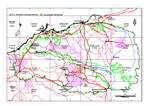Click on images
to enlarge



Photographer: B.R. Maslin

Photographer: B.R. Maslin

Photographer: B.R. Maslin

Photographer: B.R. Maslin

Photographer: B.R. Maslin
Botanical name
Acacia ? adsurgens x rhodophloia
Description
Openly branched, spreading obconic shrubs 1.5-4 m tall, dividing into numerous slender stems from near the base. Bark grey, fibrous or exfoliating in a pseudo Minni Ritchi fashion (i.e. exfoliating in narrow shavings that are shallowly recurved at each end) at base of main stems. Branchlets glabrous, smooth (no Minni Ritchi bark present), resinous (but not sticky) at extremities. New shoots bright green, resinous (but not sticky), rather shiny, glabrous or with microscopic hairs (obscured by a non-sticky resin), drying dark-coloured. Phyllodes narrowly linear, flat, (4-) 5.5-9 (-10) cm long, 2-3 (-4) mm wide, erect, somewhat thickly coriaceous, sub-rigid, dull (not shiny), pale to mid-green or slightly greyish green, straight to shallowly incurved, resinous (but not sticky), glabrous or with microscopic hairlets; parallel longitudinal nerves numerous, fine, close together and of uniform prominence; the apex coarsely pungent. Inflorescences simple or rudimentary racemes (axes 1-5 mm long), 1 or 2 per axil, often with a new vegetative shoot arising from within axil of peduncles; peduncles 7-15 mm long (about as long as the spikes), glabrous; spikes cylindrical, 10-20 mm long when dry (commonly about as long as the peduncles), rather broad (7-8 mm wide when dry), yellow, the flowers densely arranged. Flowers 5-merous; calyx ½-¾ length of corolla, shortly dissected into triangular lobes. Pods linear, 3-6 cm long, 2-3 mm wide, thinly crustaceous, glabrous. Seeds longitudinal in the pods, narrowly obloid, 4-5 mm long, 2 mm wide, somewhat shiny, very dark brown to blackish; areole very small, 'u'-shaped; pleurogram obscure and bordered by a band of dull yellow tissue; aril rather obvious and folded beneath the seed, white to cream (judging from dry material).
Characteristic features
Openly branched shrubs. Bark grey, fibrous or exfoliating in a pseudo Minni Ritchi fashion at base of main stems. Branchlets glabrous, smooth (no Minni Ritchi bark present). Phyllodes linear, long and narrow (mostly 5.5-9 cm x 2-3 mm), erect, straight to shallowly incurved, somewhat thickly coriaceous, glabrous or with microscopic hairs, resinous (but not sticky), finely and uniformly multi-striate (nerves very close together), the apex coarsely pungent. Peduncles 7-15 mm long (about as long as the densely flowered spikes). Pods linear, 3-6 cm long, 2-3 mm wide, thin-textured.
Distribution and ecology
Mostly restricted to Pilbara region of northwest Western Australia where it occurs in the central Hamersley Range between Newman and Tom Price. It is also recorded from the Gibson Desert (Western Australia) and seemingly also the Tanami Desert in Northern Territory. In the Pilbara this entity grows mostly on stony loam at base of gentle slopes, on sides of low hills and along creek lines. In the Gibson Desert it grows on deep red sand.
Flowering and fruiting period
Flowers from April/May to August. Pods (very few seen) with mature seeds have been collected in the latter half of October and judging from existing collections it would be expected that the fruiting period would extend to about the end of November.
Taxonomy
This entity requires further investigation (particularly field observation) to ascertain its taxonomic status. One herbarium label says that the bark exfoliates in a 'semi Minni Ritchi' fashion, but others say the bark is 'fibrous'. While it is possible that this entity is a hybrid involving A. adsurgens and the Minni Ritchi species, A. rhodophloia , none of the extant herbarium records show these putative parents co-occurring with it.
Affinities
On account of its long, linear, narrow, multi-striate phyllodes, spicate inflorescences and narrow pods this entity may easily be confused with A. adsurgens or narrow phyllode forms of A. rhodophloia or A. sibirica. Acacia adsurgens is recognized, however, by its longer, thinner phyllodes which, most importantly, have a central nerve that is more evident than the rest; A. rhodophloia is recognized by its red Minni Ritchi bark that commonly extends to the branchlets; and A. sibirica is recognized by its spikes being less densely flowered, broader pods, peduncles which are commonly shorter than the spikes and its smaller flowers with the calyx relatively short compared with the corolla. It could also possibly be confused with linear phyllode forms of A.? rhodophloia x sibirica which occurs within the geographic range of this entity.
Conservation status
Not considered rare or endangered.
